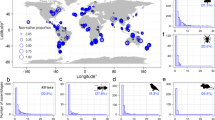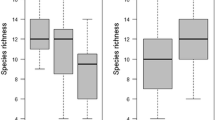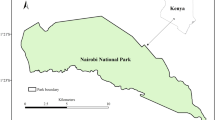Abstract
Fall armyworm (FAW) has posed a significant threat to Chinese agriculture and native species since its presence was first reported in 2019. To better understand the impacts of FAW, however, information on how FAW abundance affects native abundance and communities and whether these effects are dependent on the trophic level of native species relative to FAW is needed. Here, we studied the direction, strength, and shape of the relationship between FAW abundance and responses of native abundance and community-level metrics (mean value of unit-scaled richness, diversity, and evenness). We then tested how relative trophic position influenced these relationships. Across 25 study sites in Yunnan province, we recorded FAW abundance ranging from 0 to 715 individuals per 2666.8 m2. Across this range, native abundance declined nonlinearly by 14.6%, on average, and community metrics declined linearly by 18.1%. For lower trophic levels, FAW caused a significant nonlinear decline in native abundance (20.7%) and community metrics (28.6%), with the greatest declines occurring at low FAW abundance. At the same trophic level, native abundance (9.1%) and community metrics (14.5%) declined nonlinearly and linearly, respectively. In contrast, FAW had no significant impact on native abundance or community metrics at higher trophic levels. At the community level, negative impacts were stronger for evenness and diversity than for richness. The results of our analyses suggest native responses to FAW invasion rely strongly on FAW abundance and trophic position. The FAW abundance–native response relationships reveal how FAW impacts may develop during the invasion process and when to best manage them.



Similar content being viewed by others
References
Baiser B, Russell GJ, Lockwood JL (2010) Connectance determines invasion success via trophic interactions in model food webs. Oikos 119:1970–1976. https://doi.org/10.1111/j.1600-0706.2010.18557.x
Barney JN, Tekiela DR, Dollete ES, Tomasek BJ (2013) What is the “real” impact of invasive plant species? Front Ecol Environ 11:322–329. https://doi.org/10.1890/120120
Becker BJ, Wu MJ (2007) The synthesis of regression slopes in meta-analysis. Stat Sci 22:414–429. https://doi.org/10.1214/07-STS243
Benkwitt CE (2015) Non-linear effects of invasive lionfish density on native coral-reef fish communities. Biol Invasions 17:1383–1395. https://doi.org/10.1007/s10530-014-0801-3
Bezemer TM, Harvey JA, Cronin JT (2014) Response of native insect communities to invasive plants. Annu Rev Entomol 59:119-U740. https://doi.org/10.1146/annurev-ento-011613-162104
Borenstein M, Hedges LV, Higgins JPT, Rothstein HR (2011) Introduction to MetaAnalysis. John Wiley and Sons, West Sussex
Bradley BA, Laginhas BB, Whitlock R, Allen JM, Bates AE, Bernatchez G, Diez JM, Early R, Lenoir J, Vilà M, Sorte CJB (2019) Disentangling the abundance–impact relationship for invasive species. Proc Natl Acad Sci USA 116:9919–9924. https://doi.org/10.1073/pnas.1818081116
Byers JE, Reichard S, Randall JM, Parker IM, Smith CS, Lonsdale WM, Atkinson IAE, Seastedt TR, Williamson M, Hayes EC (2002) Directing research to reduce the impacts of nonindigenous species. Conserv Biol 16:630–640. https://doi.org/10.1046/j.1523-1739.2002.01057.x
Cameron EK, Vilà M, Cabeza M (2016) Global meta-analysis of the impacts of terrestrial invertebrate invaders on species, communities and ecosystems. Glob Ecol Biogeogr 25:596–606. https://doi.org/10.1111/geb.12436
Campos MR, Picanco MC, Martins JC, Tomaz AC, Guedes RNC (2011) Insecticide selectivity and behavioral response of the earwig Doru luteipes. Crop Prot 30:1535–1540. https://doi.org/10.1016/j.cropro.2011.08.013
Cassey P, Blackburn TM, Lockwood JL, Sax DF (2006) A stochastic model for integrating changes in species richness and community similarity across spatial scales. Oikos 115:207–218. https://doi.org/10.1111/j.2006.0030-1299.15223.x
Cock MJW, Beseh PK, Buddie AG, Giovanni C, Crozier J (2017) Molecular methods to detect Spodoptera frugiperda in Ghana, and implications for monitoring the spread of invasive species in developing countries. Sci Rep 7:4103. https://doi.org/10.1038/s41598-017-04238-y
Crall AW, Renz M, Panke BJ, Newman GJ, Chapin C, Graham J, Bargeron C (2012) Developing cost-effective early detection networks for regional invasions. Biol Invasions 14:2461–2469. https://doi.org/10.1007/s10530-012-0256-3
Cruz-Esteban S, Rojas JC, Sánchez-Guillén D, Cruz-López L, Malo EA (2018) Geographic variation in pheromone component ratio and antennal responses, but not in attraction, to sex pheromones among fall armyworm populations infesting corn in Mexico. J Pest Sci 91:973–983. https://doi.org/10.1007/s10340-018-0967-z
Early R, Bradley BA, Dukes JS, Lawler JJ, Olden JD, Blumenthal DM, Gonzalez P, Grosholz ED, Ibanez I, Miller LP, Sorte CJB, Tatem AJ (2016) Global threats from invasive alien species in the twenty-first century and national response capacities. Nat Commun 7:12485. https://doi.org/10.1038/ncomms12485
Early R, Gonzalez-Moreno P, Murphy ST, Day R (2018) Forecasting the global extent of invasion of the cereal pest Spodoptera frugiperda, the fall armyworm. NeoBiota 40:25–50. https://doi.org/10.3897/neobiota.40.28165
Estes JA, Terborgh J, Brashares JS, Power ME, Berger J, Bond WJ, Carpenter SR, Essington TE, Holt RD, Jackson JBC, Marquis RJ, Oksanen L, Oksanen T, Paine RT, Pikitch EK, Ripple WJ, Sandin SA, Scheffer M, Schoener TW, Shurin JB, Sinclair ARE, Soule ME, Virtanen R, Wardle DA (2011) Trophic downgrading of planet Earth. Science 333:301–306. https://doi.org/10.1126/science.1205106
Fan JY, Haseeb M, Ren QL, Tian TQ, Zhang RZ, Wu PX (2021) Factoring distribution and prevalence of Fall armyworm in southwest China. J Appl Entomol 145:295–302. https://doi.org/10.1111/jen.12852
France KE, Duffy JE (2006) Consumer diversity mediates invasion dynamics at multiple trophic levels. Oikos 113:515–529. https://doi.org/10.1111/j.2006.0030-1299.14140.x
Gallardo B, Clavero M, Sánchez MI, Vilà M (2016) Global ecological impacts of invasive species in aquatic ecosystems. Glob Change Biol 22:151–163. https://doi.org/10.1111/gcb.13004
Garcia AG, Ferreira CP, Godoy WAC, Meagher RL (2019) A computational model to predict the population dynamics of Spodoptera frugiperda. J Pest Sci 92:429–441. https://doi.org/10.1007/s10340-018-1051-4
Gilbert B, Levine JM (2013) Plant invasions and extinction debts. Proc Natl Acad Sci USA 110:1744–1749. https://doi.org/10.1073/pnas.1212375110
Guo JF, Zhao JZ, He KL, Zhang F, Wang ZY (2018) Potential invasion of the crop-devastating insect pest fall armyworm Spodoptera frugiperda to China. Plant Prot 44:1–10
Gutiérrez JL (2017) Modification of habitat quality by non-native species. In: Vilà M, Hulme PE (eds) Impact of biological invasions on ecosystem services, Invading nature-springer series in invasion ecology. Springer International Publishing, Cham, pp 33–47. https://doi.org/10.1007/978-3-319-45121-3_3
Hadfield JD (2010) MCMC methods for multi-response generalized linear mixed models: the MCMCglmm R package. J Stat Softw 33:1–22. https://doi.org/10.18637/jss.v033.i02
Hairston NG, Smith FE, Slobodkin LB (1960) Community structure, population control, and competition. Am Nat 94:421–425. https://doi.org/10.1086/282146
Hruska AJ, Gould F (1997) Fall armyworm (Lepidoptera: Noctuidae) and Diatraea lineolata (Lepidoptera: Pyralidae): impact of larval population level and temporal occurrence on maize yield in Nicaragua. J Econ Entomol 90:611–622. https://doi.org/10.1093/jee/90.2.611
Hulme PE (2009) Trade, transport and trouble: Managing invasive species pathways in an era of globalization. J Appl Ecol 46:10–18. https://doi.org/10.1111/j.1365-2664.2008.01600.x
IPPC (2018) First detection of fall army worm on the border of Thailand. IPPC Official Pest Report, No. THA-03/1. FAO: Rome, Italy. https://www.ippc.int/. Accessed 19 December 2018
IPPC (2019) First detection report of the fall armyworm Spodoptera frugiperda (Lepidoptera: Noctuidae) on Maize in Myanmar. IPPC Official Pest Report, No. MMR-19/2. FAO: Rome, Italy. https://www.ippc.int/. Accessed 11 January 2019
Jiang XF, Zhang L, Cheng YX, Song LL (2019) Advances in migration and monitoring techniques of the fall armyworm, Spodoptera frugiperda (J E Smith). Plant Prot 45:12–18
Kenis M, Auger-Rozenberg MA, Roques A, Timms L, Pere C, Cock M, Settele J, Augustin S, Lopez-Vaamonde C (2009) Ecological effects of invasive alien insects. Biol Invasions 11:21–45. https://doi.org/10.1007/s10530-008-9318-y
Koffi D, Agboka K, Adenka DK, Osae M, Tounou AK, Anani AMK, Fening KO, Meagher RL (2020) Maize infestation of fall armyworm (lepidoptera: noctuidae) within agro-ecological zones of Togo and Ghana in west Africa 3 yr after its invasion. Environ Entomol 49:645–650. https://doi.org/10.1093/ee/nvaa048
Koricheva J, Gurevitch J, Mengersen K (2013) Handbook of meta-analysis in ecology and evolution. Princeton University Press, Princeton. https://doi.org/10.1515/9781400846184
Law R, Watkinson AR (1987) Response-surface analysis of two-species competition: an experiment on Phleum arenarium and Vulpia fasciculata. J Ecol 75:871–886. https://doi.org/10.2307/2260211
Leung B, Lodge DM, Finnoff D, Shogren JF, Lewis MA, Lamberti G (2002) An ounce of prevention or a pound of cure: bioeconomic risk analysis of invasive species. Proc Biol Sci 269:2407–2413. https://doi.org/10.1098/rspb.2002.2179
Levine JM, D’Antonio CM (2003) Forecasting biological invasions with increasing international trade. Conserv Biol 17:322–326. https://doi.org/10.1046/j.1523-1739.2003.02038.x
Levine JM, Vila M, D’Antonio CM, Dukes JS, Grigulis K, Lavorel S (2003) Mechanisms underlying the impacts of exotic plant invasions. Proc Biol Sci 270:775–781. https://doi.org/10.1098/rspb.2003.2327
Li XJ, Wu MF, Ma J, Gao BY, Wu QL, Chen AD, Liu J, Jiang YY, Zhai BP, Early R, Chapman JW, Hu G (2020) Prediction of migratory routes of the invasive fall armyworm in eastern China using a trajectory analytical approach. Pest Manag Sci 76:454–463. https://doi.org/10.1002/ps.5530
Litt AR, Cord EE, Fulbright TE, Schuster GL (2014) Effects of invasive plants on arthropods. Conserv Biol 28:1532–1549. https://doi.org/10.1111/cobi.12350
Lu J, Li Z, Gao T, Tang X (2020) Seed bank characteristics in a Pinus densata forest and its relationship with vegetation diversity in Southeast Tibet, China. Ecol Evol 10:9214–9222. https://doi.org/10.1002/ece3.6603
Mcewan RW, Rieske LK, Arthur MA (2009) Potential interactions between invasive woody shrubs and the gypsy moth (Lymantria dispar), an invasive insect herbivore. Biol Invasions 11:1053–1058. https://doi.org/10.1007/s10530-008-9316-0
Moyle PB, Light T (1996) Biological invasions of fresh water: empirical rules and assembly theory. Biol Conserv 78:149–161. https://doi.org/10.1016/0006-3207(96)00024-9
Nakagawa S, Cuthill IC (2007) Effect size, confidence interval and statistical significance: a practical guide for biologists. Biol Rev Camb Philos Soc 82:591–605. https://doi.org/10.1111/j.1469-185X.2007.00027.x
National Agricultural Technology Extension Service Center (NATESC) (2019a) Recent reports of fall armyworm in China and neighbouring countries. Plant Pathogen and Pest Information, No. 13/2019a–4–4. NATESC: Beijing, China. https://www.natesc.org.cn/. Accessed 4 April 2019a
National Agricultural Technology Extension Service Center (NATESC) (2019b) Recent reports of fall armyworm in China. Plant Pathogen and Pest Information, No. 16/2019b–4–28. NATESC: Beijing, China. https://www.natesc.org.cn/. Accessed 6 May 2019b
National Agricultural Technology Extension Service Center (NATESC) (2019c) Major pest Spodoptera frugiperda have invaded in Yunnan, and all areas should immediately strengthen investigation and monitoring. Plant Pathogen and Pest Information, No. 7/2019c–1–18. NATESC: Beijing, China. https://www.natesc.org.cn/. Accessed 29 January 2019c
National Agricultural Technology Extension Service Center (NATESC) (2019d) Spodoptera frugiperda harms winter corn in 3 cities and states in southwestern Yunnan. Plant Pathogen and Pest Information, No. 8/2019d–1–31. NATESC: Beijing, China. https://www.natesc.org.cn/. Accessed 1 February 2019d
Paini DR, Sheppard AW, Cook DC, De Barro PJ, Worner SP, Thomas MB (2016) Global threat to agriculture from invasive species. Proc Natl Acad Sci USA 113:7575–7579. https://doi.org/10.1073/pnas.1602205113
Parker IM, Simberloff D, Lonsdale WM, Goodell K, Wonham M, Kareiva PM, Williamson MH, Von Holle B, Moyle PB, Byers JE, Goldwasser L (1999) Impact: toward a framework for understanding the ecological effects of invaders. Biol Invasions 1:3–19. https://doi.org/10.1023/A:1010034312781
Powell KI, Chase JM, Knight TM (2011) A synthesis of plant invasion effects on biodiversity across spatial scales. Am J Bot 98:539–548. https://doi.org/10.3732/ajb.1000402
Powell KI, Chase JM, Knight TM (2013) Invasive plants have scale-dependent effects on diversity by altering species-area relationships. Science 339:316–318. https://doi.org/10.1126/science.1226817
Ricciardi A, Hoopes MF, Marchetti MP, Lockwood JL (2013) Progress toward understanding the ecological impacts of nonnative species. Ecol Monogr 83:263–282. https://doi.org/10.1890/13-0183.1
Schielzeth H (2010) Simple means to improve the interpretability of regression coefficients. Methods Ecol Evol 1:103–113. https://doi.org/10.1111/j.2041-210X.2010.00012.x
Sharanabasappa D, Kalleshwaraswamy CM, Asokan R, Swamy HM, Maruthi MS, Pavithra HB, Hegde K, Navi S, Prabhu ST, Goergen GE (2018) First report of the fall armyworm, Spodoptera frugiperda (JE Smith) (Lepidoptera: Noctuidae), an alien invasive pest on maize in India. Pest Manag Hortic Ecosyst 24:23–29
Sofaer HR, Jarnevich CS, Pearse IS (2018) The relationship between invader abundance and impact. Ecosphere 9:e02415. https://doi.org/10.1002/ecs2.2415
Stokstad E (2017) New crop pest takes Africa at lightning speed. Science 356:473–474. https://doi.org/10.1126/science.356.6337.473
Strayer DL (2010) Alien species in fresh waters: Ecological effects, interactions with other stressors, and prospects for the future. Freshw Biol 55:152–174. https://doi.org/10.1111/j.1365-2427.2009.02380.x
Strayer DL, Eviner VT, Jeschke JM, Pace ML (2006) Understanding the long-term effects of species invasions. Trends Ecol Evol 21:645–651. https://doi.org/10.1016/j.tree.2006.07.007
Tallamy DW (2004) Do alien plants reduce insect biomass? Conserv Biol 18:1689–1692. https://doi.org/10.1111/j.1523-1739.2004.00512.x
Thiele J, Kollmann J, Markussen B, Otte A (2010) Impact assessment revisited: Improving the theoretical basis for management of invasive alien species. Biol Invasions 12:2025–2035. https://doi.org/10.1007/s10530-009-9605-2
Thomsen MS, Olden JD, Wernberg T, Griffin JN, Silliman BR (2011) A broad framework to organize and compare ecological invasion impacts. Environ Res 111:899–908. https://doi.org/10.1016/j.envres.2011.05.024
Thomsen MS, Byers JE, Schiel DR, Bruno JF, Olden JD, Wernberg T, Silliman BR (2014) Impacts of marine invaders on biodiversity depend on trophic position and functional similarity. Mar Ecol Prog Ser 495:39–47. https://doi.org/10.3354/meps10566
Vilà M, Espinar JL, Hejda M, Hulme PE, Jarosik V, Maron JL, Pergl J, Schaffner U, Sun Y, Pysek P (2011) Ecological impacts of invasive alien plants: a meta-analysis of their effects on species, communities and ecosystems. Ecol Lett 14:702–708. https://doi.org/10.1111/j.1461-0248.2011.01628.x
Volterra V (1926) Fluctuations in the abundance of a species considered mathematically. Nature 118:558–560. https://doi.org/10.1038/118558a0
Westbrook JK, Nagoshi RN, Meagher RL, Fleischer SJ, Jairam S (2016) Modeling seasonal migration of fall armyworm moths. Int J Biometeorol 60:255–267. https://doi.org/10.1007/s00484-015-1022-x
Westbrooks RG (2004) New approaches for early detection and rapid response to invasive plants in the United States. Weed Technol 18:1468–1471. https://doi.org/10.1614/0890-037X(2004)018[1468:NAFEDA]2.0.CO;2
Wu QL, Jiang YY, Wu KM (2019) Analysis of migration routes of the fall armyworm Spodoptera frugiperda (J.E. Smith) from Myanmar to China. Plant Prot 45:1–6
Wu PX, Ren QL, Wang W, Ma Z, Zhang RZ (2021a) A bet-hedging strategy rather than just a classic fast life-history strategy exhibited by invasive fall armyworm. Entomol Gen 4:337–344. https://doi.org/10.1127/entomologia/2021/1154
Wu PX, Wu FM, Fan JY, Zhang RZ (2021b) Potential economic impact of invasive fall armyworm on mainly affected crops in China. J Pest Sci 94:1065–1073. https://doi.org/10.1007/s10340-021-01336-9
Yokomizo H, Possingham HP, Thomas MB, Buckley YM (2009) Managing the impact of invasive species: The value of knowing the density-impact curve. Ecol Appl 19:376–386. https://doi.org/10.1890/08-0442.1
Zhang SM, Zhao YX (1996) The geographical distribution of agricultural and forest insects in China. China Agriculture Press, Beijing
Zhang RZ, Zhang YP, Jiang YX (2009) Threat and management strategies of potentially invasive insects in China. Sci China Life Sci 52:903–910. https://doi.org/10.1007/s11427-009-0126-0
Acknowledgements
We thank Kemei Zheng, the head of the plant protection and plant inspection station of Huize, Lin Zhao, the current head of the plant protection and plant inspection station of Qujing, and Qiong Zhang, the former head of the plant protection and plant inspection station of Qujing for personnel assignment. We are also grateful to Changping Chen, Daoxiang Yan, Yongcui Yang, Wendong Fu, Caifu Zhang, Xiangping Ma, Chaoyuan Fu, Quanhua Zhao, Kaixin Xu, Ruiai Li, Chaocheng Li, Guolin Li, Yunxiong Li, Guoyun Li, Qingyan Li, Wanxian Dong, Keyun Zheng, Jianjian Yang, Guizhong Tao, Peng Hu, Yunfei Li, Baoshi Hu, Xuefeng Zhang, Xiumei Lei, Fenzhi Zhao, Jinding Li, Suoyun Gao, Yumei Li, Chunguang Xie, Cang Ping, Sun Rong, Yu Jin, Changyan Pan, Yankun Zan, Yangwen Wu, Limei Deng, Maohu Cui, Li Qi, Shaoyong Li, Jiabo Li, Jiangang Zhang, Kunmeng Li, Lishu Chen, Ying Liu, Ping He (45 people in total) from the plant protection and plant inspection stations of Huize and Qujing for field survey.
Funding
This research was supported by the Strategic Priority Research Program of the Chinese Academy of Sciences (XDA19050204).
Author information
Authors and Affiliations
Corresponding author
Ethics declarations
Conflicts of interest
The authors declare no conflict of interest.
Additional information
Communicated by Sarina Macfadyen .
Publisher's Note
Springer Nature remains neutral with regard to jurisdictional claims in published maps and institutional affiliations.
Supplementary Information
Below is the link to the electronic supplementary material.
Rights and permissions
About this article
Cite this article
Wu, P., Shi, K., Zhang, T. et al. The effect of invasive fall armyworm abundance on native species depends on relative trophic level. J Pest Sci 96, 1497–1507 (2023). https://doi.org/10.1007/s10340-022-01502-7
Received:
Revised:
Accepted:
Published:
Issue Date:
DOI: https://doi.org/10.1007/s10340-022-01502-7




